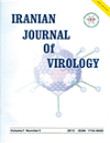فهرست مطالب
Iranian Journal of Virology
Volume:6 Issue: 3, 2012
- تاریخ انتشار: 1392/02/17
- تعداد عناوین: 6
-
-
Pages 1-7Background And AimsBovine leukaemia virus (BLV) is an oncogenic member of the genus Deltaretrovirus of the family Retroviridae. BLV is the causative agent of enzootic bovine leukaemia and infects cattle worldwide, imposing economic impact on the dairy cattle industry. The purpose of this study was to estimate the seroprevalence of BLV in cattle in some provinces of Iran.Materials And MethodsA total of 280 cows over 2 years old from 10 provinces of Iran in different regions and environments from industrial and less industrial herds were used in the study. Blood samples of all cows were taken both with and without EDTA. Serum separation for the ELISA test and leukocyte count, were performed upon receipt without delay. Cattle without fever that had lymphocyte numbers of more than 9,000/μl were suspected to have persistent lymphocytosis (PL). Sera samples were examined for antibodies against BLV by blocking ELISA.ResultsThe seroprevalence of BLV among animals was 32.8% and among provinces was 80%. Seropositive cattle had higher total leukocyte and lymphocyte count and lower neutrophil count than seronegative cattle (P<0.001). Among BLV seropositive animals, the rate of PL was 36.9%. None of the seronegative animals showed lymphocytosis.ConclusionComparing the data with previous studies on seroprevalence of BLV in different localities in Iran, the prevalence of the infection has been raised. These results suggest that promoting control programs in Iran are very important. Furthermore, it will be essential to conduct nationwide surveillance program and determine the major risk factors.Keywords: Bovine leukaemia virus (BLV), Seroprevalence, persistent lymphocytosis (PL), Iran
-
Pages 8-12Background And AimsThis study was the trends of Hepatitis B infection among Iranian blood donors which was analyzed in a period of 10 years.Materials And MethodsIn a period of 10 years, from 2001 through 2010, a total of 16,264,830 donations from 30 regional and 35 local blood services were screened. All blood samples were tested for Hepatitis B surface antigen (HBs Ag) by commercial available kits. Sistan-Baluchestan (S&B) province representing a high prevalence and Fars province was a low prevalence area. For assessing frequency of infection, the prevalence of HBS Ag per 100 000 donations and 95% confidential intervals (95% CIs) was calculated. Statistical analysis was conducted using chi-square test and considered significant if P value was <0.05.ResultsThe prevalence rates of HBs Ag dramatically declined from 1.23% in 2001 to 0.25% in 2010 in Iran. In S&B province HBs Ag prevalence decreased from 3.29% in 2001 to 0.66% in 2010 and in Fars province, the rate of HBs Ag decreased from 0.82% in 2001 to 0.12% in 2010. In this period, the number of donation progressively increased from 1361321 donation in 2001 to 1889851 donation in 2010, P v <0.00001. The number of volunteer donations increased from 92% in 2001 to 100% in 2010.ConclusionThe findings indicated that an appropriate implementation of Iranian Blood Transfusion Organization (IBTO) programs such as the selection of blood donors/ donor recruitment, increasing non-remunerated repeat donors, routine screening for blood borne viruses, replacement donation exclusion, and implementation of automation are being performed.Keywords: Hepatitis B virus_Blood Donation_Prevalence_Iranian Blood Transfusion Organization (IBTO)
-
Pages 13-18Background And AimsCrimean-Congo hemorrhagic fever (CCHF) is a zoonosis caused by a Nairovirus of the family Bunyaviridae. Infection is transmitted to humans mostly by Hyalomma ticks. This study was conducted to determine the rate of CCHFV infection in ticks in Qom province of Iran.Materials And MethodsIn this study, Reverse transcription – polymerase chain reaction (RT-PCR) was used to detect partial sequence of the CCHF small (S) genome segment in ticks.ResultsCCHFV genome was found in 7.9% of hard ticks. All positive ticks were from Hyalomma genus and Hyalomma marginatum species. We were not able to find virus in in Hy. anatolicum, Hy. schulzei, Hy. dromedarii, Rhipicephalus Sanguineus and Argas persicus.ConclusionResults exhibited that Hyalomma marginatum is the main vector in the study area.
-
Pages 19-23Background And AimsA multiplex transcription-polymerase chain reaction (m-PCR) was developed for direct detection and discrimination between canarypox virus (CPV) and other avian poxvirus (APV).Materials And MethodsThree compatible primer sets were designed for m-PCR amplification of different loci; fpv126, fpv140, and fpv167 located at highly conserved APV genes.ResultsResults showed that m-PCR products of the expected sizes were obtained for all of the primer sets when they were tested either alone or in combination with an artificial mixture of positive controls. Based on the better amplification of fpv167 than other loci, the locus primer set was used to examine tissue samples from canaries clinically diagnosed as AVP-infected.ConclusionAll canary samples were positive for CPV by the m-PCR and virus isolation. The results of the present study indicate the m-PCR assay holds potential to be versatile, rapid, and sensitive for detection of CPV and differentiation of the virus from the other APVs.
-
Pages 24-29Background And AimsCrimean-Congo hemorrhagic fever (CCHF) is a fatal viral disease that occurs in approximately 30 countries. It has the most extensive geographic range among the tick-borne viruses that affect human health. CCHF viruses have a tripartite RNA genome consisting of large (L), medium (M) and small (S) segments. This study was undertaken to determine the genetic relationship of CCHF viruses in tick population of West Azerbaijan Province of Iran.Materials And MethodsIn this study, RT-PCR method was used for detection of the CCHFV genome based on S segment. The phylogenetic relationship among the Iranian CCHF virus and also between these variants and those from other regions of the world was identified.ResultsTwo genotypes of CCHF virus were in circulation in Iran (Asia1& Europe 1). We were the first to demonstrate the presence of Europe 1 genotype of CCHF virus in Iran.ConclusionFurther epidemiologic studies including, CCHFV complete genome analysis and implementation of improved surveillance are urgently needed to better predict and respond to CCHF outbreaks in Iran and Middle East region.


